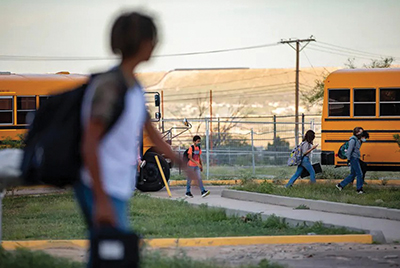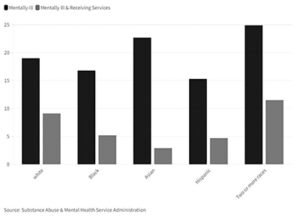
For many teachers, adapting to their students’ needs means a greater emphasis on children’s mental health. As anxiety, depression, and behavioral issues are on the rise in kids, some lesson plans have been expanded to help struggling students succeed despite facing significant challenges.
By Sam Judy

Black students with mental illness are proportionally among the least likely to pursue and receive mental health services, along with Hispanic and Asian students.
Students arrive at a middle school in El Paso on Aug. 19, 2021. In the past year, Texas Health and Human Services has spent about $3.6 billion on behavioral health services for children and adults, but Texas still ranks 51st among states and Washington, D.C., when it comes to per capita mental health spending | Photo credit: Ivan Pierre Aguirre via The Texas Tribune
Americans statistically deal with mental illness/disorder more than any other high-income nation in the world. Almost one in four adults in the United States suffers from a mental illness of some kind, including anxiety, high stress, or depression. But as 50% of mental health issues are established by age 14-17, signs of mental illness are commonly exhibited in adolescents and teens.
Likewise, our mental health crisis has manifested in younger generations as more children in schools have exhibited discernible signs of mental illness. Aside from anxiety and depression, which are present in 4.4% and 9.4% in the child population, attention deficit hyperactivity disorder (ADHD), oppositional defiant disorder (ODD), and conduct disorder (CD) are all becoming increasingly common in adolescents and pre-teens.
Black students with mental illness are proportionally among the least likely to pursue and receive mental health services, along with Hispanic and Asian students.
Black children are more susceptible to depression, anxiety, and other challenges in maintaining mental health than non-Black peers, as issues are typically more persistent. Additionally, statistics report that suicide among Black youth is increasing at a faster rate than any other racial group at 36.6%. Among other causes, racism against Black children is attributable as a huge factor and cause of poor mental health. Black adolescents are also much less likely than their white peers to seek and find mental health care.
As mental illness and behavior disorders have the potential to derail students subjected to the typical classroom environment, educators have taken steps to adapt to provide the best support in achieving academic success. Across states such as California, Texas, Colorado, and Maryland, education has been made more accessible for students with obstacles in mental wellness either through the work of teachers or school boards.
Here in Dallas, Momentous School provides an educational space that emphasizes emotional understanding and social learning as much as it does the core curriculum to a student body that is 99.5% non-white. Breathing exercises, consistent testing to monitor progress, and highly curated learning exercises are instrumented. Lessons crafted under the guidance of child psychologists and other professionals trained to work with students that need additional support or alternative learning structures. These concepts not only provide the best foundation for educational success, but for personal growth and development as well.
Momentous School’s implementation of Social-Emotional Learning runs deep and draws upon training usually only readily accessible in graduate schools. Students not only learn techniques to gain greater understanding and control of their behavior but learn about the brain itself. Thereby, teaching students not only how to communicate what they’re feeling but to understand why.
However, public schools within the Dallas Independent School District are not as fortunate as to have the comparatively vast funding of a private laboratory school. The staff has implemented some methods to promote mental wellness, but don’t necessarily provide as dynamic of a lesson plan as a school that requires tuition for enrollment.
“As a counselor I do my best. One thing I do is mentally check on each child every day at lunch,” Juanita MacFarlane at James Bowie Elementary School says. “Just by doing that I’ve caught a few kids that’ve needed help. As a counselor that’s what I do.” MacFarlane also explained that breathing exercises and stress management techniques have become more commonplace in classrooms since lockdown was lifted.
Counselors at Cedar Crest Elementary also confirm the integration of these methods, citing mental breaks, breathing exercises, and check-ins with students to maintain mental wellness among the student body. However, a student’s struggles are typically more personalized and emphasized within a specific child’s issues, helping them overcome these issues to attune to public mainline or special education rather than being directly accustomed to integrating these techniques in the curriculum’s design.
Mental Health Director of DISD Dr. Tracey Brown explains that counseling is one composite aspect of how mental health is addressed in more serious cases.
“We work with all our students directly to ensure that they’re mentally in good health,” Dr. Brown says. “We train our teachers and staff to recognize symptoms. At that point, we send them to counselors to determine the cause of those issues, whether that’s something at home or things just aren’t connected in their understanding. We then get a referral from the counselor to receive help from our clinician on-staff and get parental consent to include them when coming up with solutions.”
These solutions can also include psychiatry or child therapy services. If at this point a student is qualified for specialized learning or needs additional attention, a child will be transferred to the appropriate classrooms within their school.
While accessibility to specialized learning for students struggling with behavioral issues arising from poor mental health is available for children attending public school, primary curricula with integration of more dynamic concepts is expectedly centralized to private institutions with more freedom and capital to experiment. As Texas public education does not enact initiatives – let alone allocate funding – for a more full-fledged approach, deeply comprehensive learning experiences for children struggling with depression, anxiety, or behavioral challenges remain more attainable for the middle and upper-class.


Be the first to comment